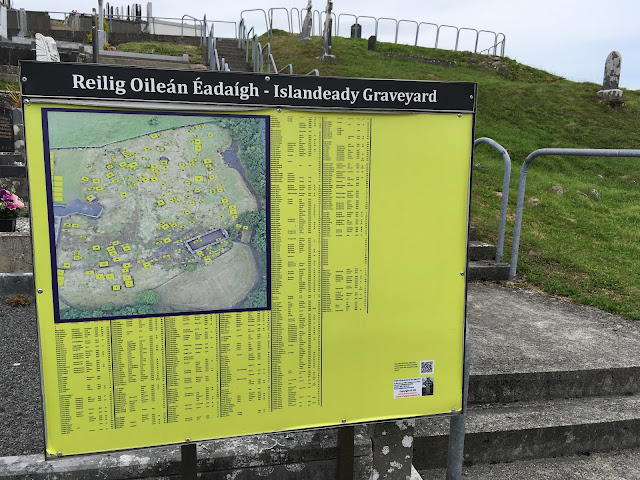In a previous post, we explored the family history of Charles O'Malley of Cloonane (1779-1871). Charles was reportedly a descendant of Teige, a supposed brother of the famous Grace O'Malley (1530-1603). We had previously thought that this line had died out ... but recent discoveries have suggested that this may not be the case!
I've been travelling around Mayo for the past week or so and on Wednesday (17th August) I decided on an excursion to the beautiful countryside around Islandeady to visit the grave of Charles of Cloonane and pay my respects in person. Islandeady lies half-way between Westport and Castlebar.
 |
| Me with my trusty 26-year-old Saab outside the church in Islandeady |
The Islandeady graveyard is divided into the old and new sections and it was in the former that Charles and his family have been laid to rest. A company called Irish Graveyards has previously surveyed both sections of the cemetery and there is a handy index of everyone resting there and a map of their locations.
 |
| The cemetery map and index to the gravestones |
Charles' grave was easy to find and the gravestone clearly states that his wife's name was Alice Bourke, filling in a missing piece of information discussed in the previous post.
 |
| Gravestone of Charles O'Malley & Alice Bourke |
There were several other O'Malley gravestones of interest in the graveyard, including that of Letitia O'Malley-Keyes (1853-1923) and her family (mother, father, siblings). Letitia was the wife of Middleton O'Malley (1826-1902) of Ross House from Line 1 of the Finding Grace project (reported descendants of Grace's supposed brother Melaghlin).
 |
| Letitia O'Malley-Keyes and family |
I also found a gravestone within the church for a Martin O'Malley who died on 15th Dec 1811 aged 55 years and would thus have been born about 1756. I'm not sure where he sits in the greater O'Malley Clan Family Tree, or if he is related to Charles of Cloonane, or if he has any living descendants today.
 |
| Martin O'Malley 1756-1811 |
There were several old slabs lying just outside the old church, one of which was for an O'Maly. A partial transcription is on the Irish Graveyards website (plot no. 24) and reveals that Mr O'Maly died in August 1788 aged 82 (hence, born in 1704) and his wife, Catherine O'Malley died in July 1789 aged 96. This would mean she was born about 1693 indicating the O'Malley presence in Islandeady probably extends back into the 1600s at least.
 |
| The name O'Maly is clearly visible on this old gravestone (plot no. 24) |
A second slab has a partial transcription on the IrishGraveyards website that reads: James O'Malley died 1790, aged 18. However, there is clearly additional text on the gravestone that would be worth capturing. It would be good to get some gravestone rubbings to help reveal the full extent of the inscriptions.
 |
| Another old O'Malley gravestone (plot no. 17) |
I also came across this touching memorial to Fr Thomas O'Malley (son of Charles of Cloonane) in the parish church in Islandeady itself. Father Tom was a much loved parish priest (P.P.) and was very active in fighting for the rights of his parishioners during the land wars of the 1870s and 1880s, saving many tenants from being evicted by their landlord.
 |
| Memorial to Fr Thomas O'Malley (1821-1897) |
Not far from Islandeady is Jack's Old Cottage in Derrycouraune. This is a charming 200-year-old home that has been lovingly restored to its former glory by Joe & Irene Moylette, and is well worth the visit. The cottage is typical of where our ancestors would have lived 200 years ago. Check out their Facebook page here.
 |
| Jack's Old Cottage, Derrycooraune, Islandeady |
Joe and Irene are heavily involved in the Islandeady Heritage Group who are actively involved in preserving and promoting the local history, genealogy and heritage. Keep up the good work!
 |
| List of achievements of the Islandeady Heritage Group |
I spoke to Joe (087 9443626, jacksoldcottage@gmail.com) and he was very helpful in suggesting living O'Malley's to contact whose families have lived in Islandeady for many generations. Some of them are probably related to Charles of Cloonane (1779-1871) so it may very well be that the line has not died out as previously thought. If that is the case, we may be able to test several descendants of Teige, the supposed brother of Grace O'Malley.
There is no substitute for local knowledge!





